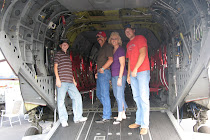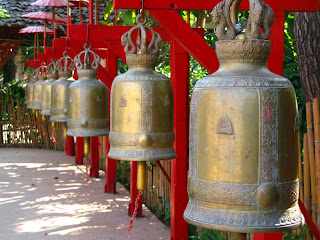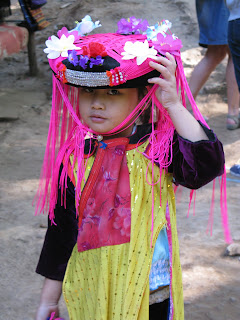After a long, 6 hour bus ride from Ayutthaya, I arrived in Sukhothai, which literally means "Dawn of Happiness." The city was founded in the year 1238 A.D. and was capital of Thialand for approximately 120 years.
The temples and buildings here are mostly concentrated within the main gate. I'm sure you got enough history about the Khmer era, so I'm just going to post a few pics for this one. I wasn't as impressed with Sukhothai as I was with Ayutthaya. The great thing about Sukhothai are the posts with pictures of the reconstructed temple. I have included a few of the recognizable comparisons below.
Wat Mahathat
To the Northern Gate
Ta Daeng Shrine
Wat Si Chum
I ride my bicycle
Renting a bicycle in towns with ruins has become a favorite activity. Freedom from the hassles of haggling as well as I'm able to stop anywhere I please for a picture.
Wat Traphang Ngoen
Wat Si Sawai
My Peanut Lady. Adorable site right next to the Wat Mahathat in Sukhothai. Seeing her just makes you want to munch on peanuts.
Chiang Mai
Thailand's Second City
After another long, 6 hour bus ride I arrived in the popular tourist destination of Chiang Mai in northern Thailand. Thailand's second city. Chiang Mai is a city of everything (except beaches). It manages to preserve an enticing atmosphere of overgrown village life and a laid back backpacker oasis. Set in the picturesque hills, Chiang Mai attracts tourists with its elephant rides, night markets, trekking, white water rafting, monkey zoos, night safari, street stalls, village visits, zip lining, cooking schools, tiger temple, tubing, caves, an orchid farm, massages (by the blind, disabled, and imprisoned), contemporary shops, and fine dining all the way down to fried roaches. It doesn't hurt that there are really cool backpacker places (Deejai's) for 99 baht ($3.34) a night and 24 hour bicycle rentals for 50 baht ($1.67). Its a backpackers dream!
Upon arrival, around 7pm, I threw down my bag and headed out to call for a tuk tuk to visit the local night bazaar. I was thoroughly impressed with the size of it, but the monotony of items in the stalls made for a short shopping experience. While walking around I happened upon the Anusarn Market with unique tribal ware and Chinese/Thai food. While shopping for a small, embroidered handbag, I overheard the familiar tone of "Sweet Home Alabama". I followed the tune to a nearby bar and was surprised to see a band of 5 Thais belting out the Alabama favorite. It reminded me of the day I was exploring the Wat Phra Si Sanphet in Ayutthaya where I was serenaded by "Gangnum Style". Oh the mutiny never ceases to entertain me.
Thai Cooking with Da
I took a Thai food class where I went to an organic rice farm and cooked 4 dishes in an outdoor kitchen. I can't say that I would make any of these meals at home, simply because buying all of the ingredients would be expensive and hard to find, although cooking with them was a treat! Chicken in coconut milk soup, yellow curry paste and curry, Pad Thai, and mango sticky rice made for a huge setting at the table. We all pigged out and enjoyed the onset of evening while chatting away.
A few temples of Chiang Mai.
Hilltribes of Northern Thailand
There are at least ten different hilltribes in northern Thailand and I think I met someone from about five of them. Migrating from various parts of China and Burma, most arrived in Thailand in the twentieth century and many have tribal relatives in other parts of Southeast Asia.
The tribes have sophisticated systems of customs, laws and beliefs, and are predominantly animists.
They often have exquisitely crafted costumes, but have recently adopted Western clothes, stripping them of their distinct customs. I tried to visit the tribal museum in Chiang Mai, but upon arrival of a 10 km bike ride, I found a burnt pagoda and a deserted lake community of restaurants that used to cater to tourists. As I road around the lakeside cabanas I wondered how these communities make a living now that their businesses have gone under. It was quite depressing actually.
Karen Tribe of Long-Neck Women
The largest hill tribe group (pop. 500,000), the Karen began to arrive in Thailand in the seventeenth century, though many are recent refugees from Burma fleeing to escape repression. Unmarried Karen women can be seen wearing loose v-neck shift dresses and skirts in bold red or blue. There is a subgroup that is named White Karen because the unmarried women wear white. Perhaps the most well known of all the hilltribe groups are the Paduang, a small subgroup of the Karen whose women wear columns of heavy brass rings around their necks.
Though the women's necks appear to be stretched up to 30 cm , the pressure of 11 pounds of brass actually compresses the collarbones and ribs. To remove a full stack would cause the collapse of the neck and suffocation. Little girls start wearing the rings from about the age of 6, adding one or two each year until they are 16. Only about half of the Praduang women now wear the rings. If it wasn't for tourism, the custom would probably have already died out. Women and children are put to work all day weaving fabric on a traditional loom.
Homemade Hammock. Totally making my future kid one of these!
Akha Tribe Village
The poorest of the hill tribes, Akha (pop. 50,000) villages are characterized by houses on low stilts and steeply pitched roofs. Women wear elaborate headgear consisting of a conical wedge of white beads interspersed with silver coins, topped with plumes of red taffeta and framed by dangling silver balls. While walking through a village of today, I couldn't help but wonder how these tribes used to live and how much tourism has affected their daily living.
From women running up to the group begging and fighting over who to buy from to most villagers going into hiding, are they really OK with outsiders invading their privacy everyday. Between the two "villages" I visited, it did feel like an unappreciated 'human zoo'. I just hope the hilltribe people are living their life the way they choose and are not being forced by government to be there.
Going Out
Lady-boy who loves Siam wine. Yucky!
Village Life
I finally connected with a Peace Corps Volunteer of Thailand!! Kathleen was gracious enough to welcome me into her home somewhere between Chiang Mai and Chiang Khong. Her site was actually quite developed and probably referred to more as a town than a village, but true local culture was abundant and not another Farang (French person, but now referring to all white people) was in sight! I absolutely loved chatting with her about the differences between PC Thailand and PC Fiji. It seems they are strapped down a bit by more rules coming from the Peace Corps office as well as quite a different dynamic in their group of volunteers. Everyone has their qualms with the culture, and often volunteers vent about it, but truly deep down inside, we learn to accept the differences and possibly even love and laugh about it. For example, the way Fijians heal boils. By using shavings from a bar of soap and several hibiscus flowers they grind up a potion that they believe heals a boil. Now, maybe there is some truth to that, but scientifically, the only thing I can muster out of all of that is craziness. :) I still love you Fiji peeps!
Over the course of my month in Thailand I learned that Thai people hold a grudge forever after one wrong has been done. Middle class and above are typically extremely clean and strongly dislike smelling others. They are 95% Buddhists and many of the men will be a monk for some period of their lives. They save face, telling you what you want to hear, but not doing what they say. Everyone wants to be whiter, so every face wash, body wash, cream, etc. has whitening in it.
Local bus from Kathleen's village to Chiang Khong, the border of Thailand and Laos.
Tiger Kingdom
At first I was a bit skeptical about visiting Tiger Kingdom because of all the horror stories I heard about Tiger Temple in Bangkok allowing the monks to take the tigers from the wild and drug them for tourism. Although these allegations may or may not be true, I did my research before being talked into going to Tiger Kingdom in Chiang Mai. As far as I can tell the tigers are in a conservation program and were never taken from the wild or harmed beyond positive reinforcement. They respond by name, have playmates, are given a good deal of rest, and appear to be in their natural state besides not being inthe wild. Tigers naturally sleep 14-18 hours a day, so visitors are more than likely going to visit when the tigers are inactive, making for easy photo opportunities. Mark and I arrived in the late afternoon hoping the tigers would be awake and on the prowl. We were in luck. Almost all of the tigers were either wrestling with each other, playing with manmade toys, or preparing to pounce on a nearby bird up above. We read the rules which included "do not approach a tiger from the front" and "tigers love their belly rubbed" and were introduced to our tiger handler. Moving around the enclosure with four adult tigers on the move was actually an intimate experience. Getting up close for a good shot was a welcomed challenge.
Mark and I were quickly laying up next to Leo, rubbing his belly and stroking his wet, somewhat course fur. He wasn't keen on staying still long and we soon found ourselves searching out another tiger to tease. Walking among these gentle giants was truly an experience I never imagined and was happy to have been dragged into.
This is a Songthaew (song-ta-ow), the best form of transport because they work like a taxi, but pick up and drop off along the way to one of the requested destinations, resulting in an economical and efficient hop on, hop off, trolley-type system. The price for your destination can also always be negotiated.
Subscribe to:
Comments (Atom)







































































































